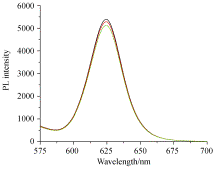1 Zhang, L. Y.; Zheng, H. Z.; Long, Y. J.; Huang, C. Z.; Hao, J. Y.; Zhou, D. B. Talanta 2011, 83, 1716.

2 Tavares, A. J.; Chong, L. R.; Petryayeva, E.; Algar, W. R.; Krull, U. J. Anal. Bioanal. Chem. 2011, 399, 2331.

3 Byers, R. J.; Hitchman, E. R. Prog. Histochem. Cytochem.2011, 45, 201.

4 Sheng, Z. H.; Han, H. Y.; Hu, X. F.; Chi, C. Dalton Trans.2010, 39, 7017.

5 Xu, X.; Kong, Y.-F.; He, R.; Ji, J.-J.; Cui, D.-X. Acta Chim. Sinica 2011, 69, 931 (in Chinese). (徐昕, 孔毅飞, 贺蓉, 吉佳佳, 崔大祥, 化学学报, 2011,69, 931.)
6 Peng, Z. A.; Peng, X. G. J. Am. Chem. Soc. 2001, 123, 183.

7 Uyeda, H. T.; Medintz, I. L.; Jaiswal, J. K.; Simon, S. M.; Mattoussi, H. J. Am. Chem. Soc. 2005, 127, 3870.

8 Darbandi, M.; Thomann, R.; Nann, T. Chem. Mater. 2005,17, 5720.

9 Lees, E. E.; Nguyen, T. L.; Clayton, A. H. A.; Mulvaney, P.; Muir, B. W. Acs Nano 2009, 3, 1121.

10 Aldana, J.; Wang, Y. A.; Peng, X. G. J. Am. Chem. Soc.2001, 123, 8844.

11 Chan, Y.; Zimmer, J. P.; Stroh, M.; Steckel, J. S.; Jain, R. K.; Bawendi, M. G. Adv. Mater. 2004, 16, 2092.

12 Pellegrino, T.; Manna, L.; Kudera, S.; Liedl, T.; Koktysh, D.; Rogach, A. L.; Keller, S.; Radler, J.; Natile, G.; Parak, W. J. Nano Lett. 2004, 4, 703.

13 Wuister, S. F.; Donega, C. D.; Meijerink, A. J. Phys. Chem. B 2004, 108, 17393.

14 Yu, W. W.; Chang, E.; Falkner, J. C.; Zhang, J. Y.; Al-Somali, A. M.; Sayes, C. M.; Johns, J.; Drezek, R.; Colvin, V. L. J. Am. Chem. Soc. 2007, 129, 2871.

15 Li, J. J.; Wang, Y. A.; Guo, W. Z.; Keay, J. C.; Mishima, T. D.; Johnson, M. B.; Peng, X. G. J. Am. Chem. Soc. 2003,125, 12567.

16 Xie, R. G.; Kolb, U.; Li, J. X.; Basche, T.; Mews, A. J. Am. Chem. Soc. 2005, 127, 7480.

17 Hines, M. A.; Guyot-Sionnest, P. J. Phys. Chem. 1996, 100,468.

18 Peng, X. G.; Schlamp, M. C.; Kadavanich, A. V.; Alivisatos, A. P. J. Am. Chem. Soc. 1997, 119, 7019.

19 Meier, R.; Henning, T. D.; Boddington, S.; Tavri, S.; Arora, S.; Piontek, G.; Rudelius, M.; Corot, C.; Daldrup-Link, H. E. Radiology 2010, 255, 527.

20 Anbharasi, V.; Cao, N.; Feng, S. S. J. Biomed. Mater. Res. A 2010, 94A, 730.
21 Sun, Y.; Chen, L. B.; Yu, J.; Zhi, X. L.; Tang, S. X.; Zhou, P.; Wang, C. C. Anti-Cancer Drugs 2009, 20, 607.






















